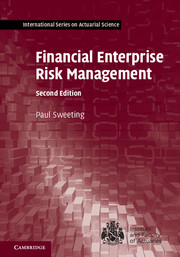Book contents
- Frontmatter
- Contents
- Preface
- 1 An Introduction to Enterprise Risk Management
- 2 Types of Financial Institution
- 3 Stakeholders
- 4 The Internal Environment
- 5 The External Environment
- 6 Process Overview
- 7 Definitions of Risk
- 8 Risk Identification
- 9 Some Useful Statistics
- 10 Statistical Distributions
- 11 Modelling Techniques
- 12 Extreme Value Theory
- 13 Modelling Time Series
- 14 Quantifying Particular Risks
- 15 Risk Assessment
- 16 Responses to Risk
- 17 Continuous Considerations
- 18 Economic Capital
- 19 Risk Frameworks
- 20 Case Studies
- 21 Solutions to Questions
- References
- Index
3 - Stakeholders
Published online by Cambridge University Press: 12 August 2017
- Frontmatter
- Contents
- Preface
- 1 An Introduction to Enterprise Risk Management
- 2 Types of Financial Institution
- 3 Stakeholders
- 4 The Internal Environment
- 5 The External Environment
- 6 Process Overview
- 7 Definitions of Risk
- 8 Risk Identification
- 9 Some Useful Statistics
- 10 Statistical Distributions
- 11 Modelling Techniques
- 12 Extreme Value Theory
- 13 Modelling Time Series
- 14 Quantifying Particular Risks
- 15 Risk Assessment
- 16 Responses to Risk
- 17 Continuous Considerations
- 18 Economic Capital
- 19 Risk Frameworks
- 20 Case Studies
- 21 Solutions to Questions
- References
- Index
Summary
Introduction
The nature of an organisation gives the basis on which other aspects of the risk management context can be built. One of the more important aspects is the nature of the relationships that various stakeholders have with an institution. There are a number of ways in which these relationships can be described, but a good starting point is to classify them into one of several broad types, these types being:
• principal;
• agency;
• controlling;
• advisory; and
• incidental.
In this chapter, these relationships are considered in more detail, to make it easier to understand where risks can occur.
Principals
All financial institutions need and use capital (as do all non-financial institutions), and the principal relationships describe those parties who either contribute capital to or receive capital from the institution. Providers can be categorised broadly into those who expect a fixed, or at least predetermined, return on their capital (providers of debt capital, debt-holders) and those who expect whatever is left (providers of equity capital, shareholders). The former will generally be creditors of the institution. This means that they have lent money to the institution, and are reliant on the institution being able to repay the debt. Shareholders, on the other hand, are not owed money by the institution; rather, they can be regarded as part owners of the institution. On the other side, institutions have relationships with their customers. The customers provide the raison d’être of the institution. Financial institutions also have a number of relationships with governments. Among these are direct financial relationships, justifying the inclusion of governments in this category. Whilst these now include the provision of financial support for some institutions, including privatisation, this is really only the government acting as a provider of capital. The relationships that are exclusively governmental more typically involve taxation. Finally, as well as drawing capital from capital markets, financial institutions are unique in that they are also significant investors in capital markets. Similarly, whilst some financial institutions provide insurance, many also purchase insurance, often due to statutory requirements and generally in order to protect their customers. In the context of relationships, markets are generally insensitive to the actions of an individual investor.
- Type
- Chapter
- Information
- Financial Enterprise Risk Management , pp. 20 - 53Publisher: Cambridge University PressPrint publication year: 2017



